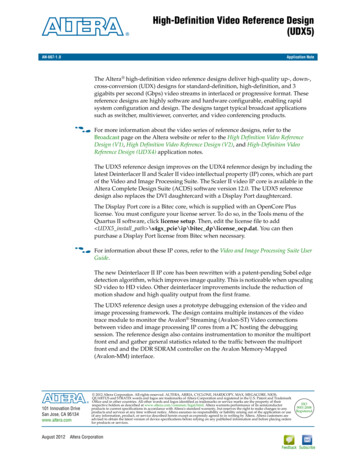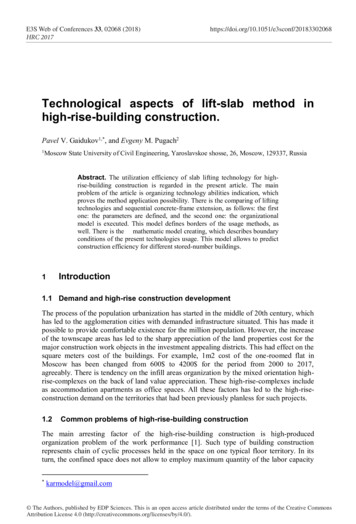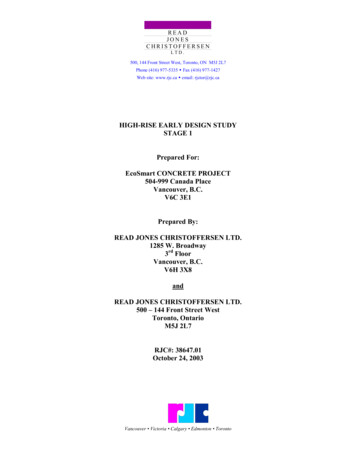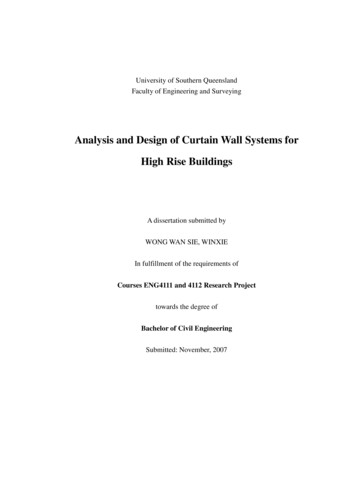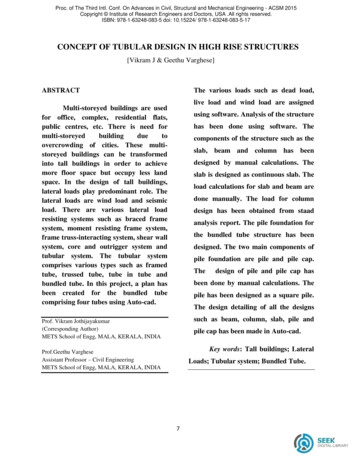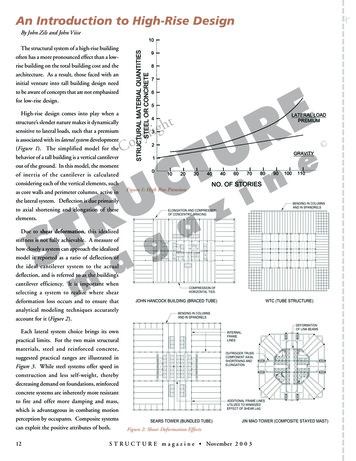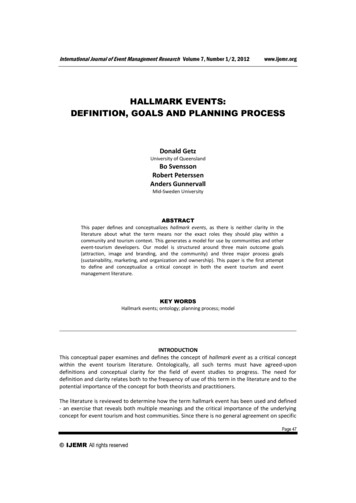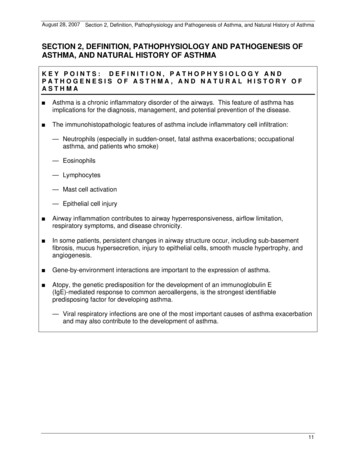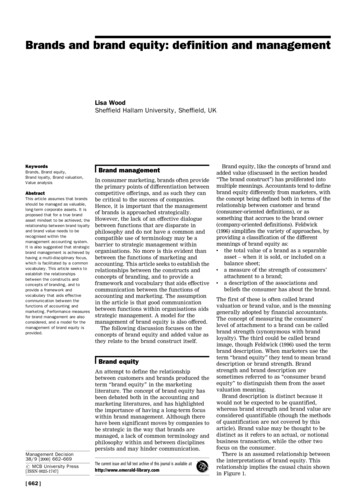
Transcription
1High-Rise BuildingDefinition, Development,and UseThe interesting question is why does man want to build to the sky. Whatis there about the desire for domination, or to reach God, or for privatepride—the Pyramids are an example of that, but the tall building is certainlyanother.—Skyscrapers Introductory Interview with Philip Johnson1Before entering the world of high-rise security and fire life safety, it is important todefine what constitutes a high-rise building and to review the development and utilization of these unique structures.What Is a High-Rise Building?A building is an enclosed structure that has walls, floors, a roof, and usually windows.“A ‘tall building’ is a multi-story structure in which most occupants depend on elevators[lifts] to reach their destinations. The most prominent tall buildings are called ‘high-risebuildings’ in most countries and ‘tower blocks’ in Britain and some European countries.The terms do not have internationally agreed definitions.”2 However, a high-rise building can be defined as follows: “Any structure where the height can have a serious impact on evacuation” (TheInternational Conference on Fire Safety in High-Rise Buildings).3“For most purposes, the cut-off point for high-rise buildings is around sevenstories. Sometimes, seven stories or higher define a high-rise, and sometimes thedefinition is more than seven stories. Sometimes, the definition is stated in terms oflinear height (feet or meters) rather than stories.”4“Generally, a high-rise structure is considered to be one that extends higher thanthe maximum reach of available fire-fighting equipment. In absolute numbers, this1Dupré J. Skyscrapers. New York: Black Dog & Leventhal Publishers, Inc. (Copyright 1996, First BlackDog & Leventhal Paperbacks, edition 2001:7.)2Challinger D. From the Ground Up: Security for Tall Buildings CRISP Report. Alexandria, VA: ASISFoundation Research Council; 2008:4.3As stated in Wikipedia Encyclopedia, High-rise. January 5, 2009. http://en.wikipedia.org/wiki/High-risebuilding ; January 16, 2009.4Hall Jr JR. High-Rise Building Fires. Quincy, MA: National Fire Protection Association; August 2005:2.High-Rise Security and Fire Life SafetyCopyright 2009 by Elsevier Inc. All rights of reproduction in any form reserved.11 Y555 Ch01.indd 114/13/2009 7:18:34 PM
2HIGH-RISE SECURITY AND FIRE LIFE SAFETYhas been set variously between 75 feet (23 meters)䉬 and 100 feet (30 meters),”5 orabout seven to ten stories (depending on the slab-to-slab distance between floors).The exact height above which a particular building is deemed a high-rise is specified by fire and building codes for the country, region, state, or city where the building islocated. When the building exceeds the specified height, then fire, an ever-present dangerin such facilities, must be fought by fire personnel from inside the building rather thanfrom outside using fire hoses and ladders.For practicality and convenience such a multi-level or multi-story structure useselevators as a vertical transportation system and, in addition, some utilize escalators tomove people between lower floors.Development of High-Rise Buildings“From the individual ‘skyscraper’䉬䉬 to the urban clusters of ‘concrete canyons,’ thenames for high-rise buildings have always combined a kind of admiration and reverence for the magnitude of the feat with a kind of fear about the threat to human valuesimplicit in operating on so large a scale. The Tower of Babel䉬䉬䉬 is cited as a warningagainst pride and over-reaching, not as a goal to be sought.”6According to the Old Testament, after the Flood, people wanted to make a namefor themselves by building a city called Babel with a tower that reached into heaven.The tower was constructed using brick for stone and tar (asphalt) for mortar.“Come, let us build for ourselves a city, and a tower whose top will reachinto heaven, and let us make for ourselves a name; lest we be scatteredabroad over the face of the whole earth.”And the Lord came down to see the city and the tower which the sonsof men had built.And the Lord said, “Behold, they are one people, and they all have thesame language. And this is what they began to do, and now nothing whichthey purpose to do will be impossible to them.䉬For example, in the United States, commonly recognized as the home of the first high-rise, “NFPA 101[Life Safety Code ] defines a high-rise building as a building more than 75 ft (22.5 m) in height where thebuilding height is measured from the lowest level of fire department vehicle access to the floor of the highestoccupiable story. This definition is consistent with many model building codes, but it should be noted thatmany different definitions exist in local jurisdictions that use varying height and measurement criteria. Theseheight changes can range from 40 ft (12 m) to as high as 150 ft (45 m).” Holmes WD, PE. Occupancies inspecial structures and high-rise buildings. In: Fire Protection Handbook. 19th ed. Quincy, MA: National FireProtection Association; 2003:13–19.5Knoke ME, Managing Editor, CPP. High-rise structures: life safety and security considerations. In:Protection of Assets Manual. Alexandria, VA: ASIS International; 2006.䉬䉬“The word skyscraper is just as it sounds: a fanciful, rather exaggerated term designed to communicatepeople’s awe and excitement about tall buildings. In reality, its meaning has changed radically in the hundredor so years since it came into our language. In the 1890s a building of ten stories more than qualified as askyscraper, but today the word is rarely used to describe a building of fewer than fifty stories” (Sonder B.Skyscrapers. New York: MetroBooks, Michael Friedman Publishing Group; 1999:II).䉬䉬䉬The word Babel is from the Hebrew balal (to mix up) (Levi M, Salvadori M. Why Buildings Fall Down:How Structures Fail. New York and London: W. W. Norton & Company; 1992:18). In an earlier book, MarioSalvadori refers to “mankind’s aspiration to reach the sky, the ‘Tower of Babel Complex’” (Why BuildingsStand Up: The Strength of Architecture. New York and London: W. W. Norton & Company; 1992:21).6Hall Jr JR. High-Rise Building Fires. Quincy, MA: National Fire Protection Association; August 2005:1.11 Y555 Ch01.indd 24/13/2009 7:18:34 PM
Chapter 1 High-Rise Building Definition, Development, and Use3“Come, let Us go down and there confuse their language, that they maynot understand one another’s speech.”So the Lord scattered them abroad from there over the face of thewhole earth; and they stopped building the city.Therefore its name was called Babel, because there the Lord confusedthe language of the whole earth.7“During the rapid growth of the Roman Empire under the reigns of Julius andAugustus Caesar, the city of Rome became the site of a large number of hastily constructed apartment buildings—many of which were erected to considerable heights.䉬Because building collapse due to structural failure was frequent, laws were passedthat limited the heights of buildings—first to 70 feet (21 m) and then 60 feet (18 m).”8According to Sir Peter Hall’s Cities in Civilization,Within Rome the old-style town house, domus, survived well into the earlythird century AD. But, at least as early as the third century BC, overcrowding in the city was producing a new urban form, the apartment block, orinsula; Vitruvius commented that “the majesty of the city and the considerable increase in its population have compelled an extraordinary extensionof the dwelling houses, and circumstances have constrained men to take refuge in increasing the height of the edifices.”9 Building heights rose to at leastthree storeys in the third century BC, to five or more by the first centuryBC; Julius Caesar set a limit of seventy Roman feet, Augustus reaffirmed it,Trajan reduced it to sixty feet for greater safety; later still, after the greatfire, Nero prohibited the rebuilding of tenement houses and of narrow, winding lanes, laying out broad streets flanked with colonnades. In fact, from theRepublic onwards the Romans found it necessary to make regulations tocontrol the thickness of walls, the quality of building materials, and the roofsand height of buildings. Enforcement must have been a problem, for thereseems to have been no requirement to notify the authorities, as opposed topossibly interested third parties, of any proposed new structure. Since therewas no mechanism to require planning consent, any initiative had to be takenby some interested party.10So, despite these edicts, new apartment houses continued to be builtfive or six storys high.7Genesis, Chapter 11, verses 4–9. The Scripture text of the New American Standard Bible is used bypermission of the Lockman Foundation, a corporation not for profit, La Habra, CA. (Copyright 1960, 1962,1963, 1968, 1971, 1972, 1973, 1975, 1977. All rights reserved.)䉬“Residential buildings up to 5 or 6 stories have been common from the time of ancient Rome” (Mir M.Ali, ed. Catalyst for Skyscraper Revolution, Lynn S. Beedle: A Legend in His Lifetime. Chicago, IL: Councilon Tall Buildings and Urban Habitat, Illinois Institute of Technology; 2004:194).8Cote AE, Grant CC. Codes and standards for the built environment. In: Fire Protection Handbook. 19thed. Quincy, MA: National Fire Protection Association; 2003:1–51).9Carcopini 1941, 25 as referenced in Sir Peter Hall. Cities in Civilization. New York: Pantheon Books;1998:627.10Carcopini 1945, 24; de Camp 1970, 168; Hughes and Lamborn 1923, 20; Korn 1953, 32; Morris 1979,45; Robinson, N. 1992, 34–35, 41 as referenced in Sir Peter Hall. Cities in Civilization. New York: PantheonBooks; 1998:627.11 Y555 Ch01.indd 34/13/2009 7:18:34 PM
4HIGH-RISE SECURITY AND FIRE LIFE SAFETY[A]partments were mostly built with wood frames; and they wereso high and poorly built that they were in constant danger of collapse ordestruction by fire.11Throughout subsequent history there have been other tall structures—pyramidsand towers, castles and cathedrals䉬—but it was not until the end of the 19th centurythat the skyscraper was born.More than 150 years ago, cities looked very different from the way they look today.The buildings that housed people and their businesses were rarely over the height of a flagpole. Urban landscapes tended to be flat and uniform in pattern, apart from monuments,temples, and town halls; and cathedrals (adorned with domes, spires, or towers) which“towered above everything else in a city or town; they were visible from miles away.”12“Historically, the word tower usually designated the church and the town hall until the birthof the skyscraper. The main evolutionary change has been in function, from a Campanilewatchtower of the Renaissance or minaret of Islamic architecture to the office building.”13Two major developments led to the skyscrapers that dominate major city skylinesthroughout the modern world:1. In 1853, an American, Elisha Graves Otis, invented the world’s first safety lift orelevator.䉬䉬 This new form of vertical transportation䉬䉬䉬 enabled people to travelsafely upward at a much greater speed and with considerably less effort than bywalking (Figure 1–1).11Sir Peter Hall. Cities in Civilization. New York: Pantheon Books; 1998:627–629.“Gothic architecture, which began with the construction of St. Denis Cathedral in 1144, flourished wellinto the Renaissance era” (Schmidt AJ. Under the Influence: How Christianity Transformed Civilization.Grand Rapids, MI: Zondervan; 2001:296).12Schmidt AJ. Under the Influence: How Christianity Transformed Civilization. Grand Rapids, MI:Zondervan; 2001:296.13Beedle LS, Mir M. Ali, Armstrong PJ. The Skyscraper and the City: Design, Technology, and Innovation.Lewiston, NY: The Edwin Mellen Press; 2007:12.䉬䉬According to the Los Angeles Times, referring to comments made by Otis Company officials, “The‘vertical transportation industry’ began in ancient Greece. In 236 BC, mathematician Archimedes built ahoisting device using ropes and pulleys. A few centuries later, Roman gladiators and lions rode primitiveelevators to reach the floor of the Coliseum. Donkey-powered lifts were the rage of the Middle Ages. By the1800s, steam-powered hoists began transporting miners to and from underground veins of ore” (Rivenburg R.Going up: 150 years of advances in elevators. Los Angeles Times. April 5, 2003:E–1). “Otis hadn’t inventedthe first hoist. But he had invented the first ‘safe’ hoist . People had been building hoists of various kinds forhundreds of years. And they all had the same serious defect: they plunged to the bottom every time the liftingcable snapped” (Tell Me About Elevators. Farmington, CT: Otis Elevator Company; 1974:8–10).In 1854, “In front of a crowd of spectators and journalists at the Crystal Palace of New York Exhibitionhe [Elisha Graves Otis] cut the cable of his elevator, which locked in place and did not fall [Figure 1–1]. Thisrack and pinion safety lock which operates between the guiding rails and the elevator if it moves too fast, isstill in use today” (Mierop C. Skyscraper Higher and Higher. Paris, France: Institut Francais D’Architecture;1995:70–71). Otis elevators were first constructed for freight purposes. The world’s first passenger elevatorwas installed in 1857 by Otis in the five-story store of E. V. Haughwout & Company in New York City (TellMe About Elevators. Farmington, CT: Otis Elevator Company; 1974:11).䉬䉬䉬“Elisha Graves Otis developed the first safe steam-powered roped elevators with toothed guide railsand catches in the late 1850s. The steam-powered hydraulic elevator, which was limited to buildings ofabout 15 stories, was developed in 1867 by the French engineer Léon Édoux. The development of the electricmotor by George Westinghouse in 1887 made possible the invention of the high-speed electric-powered ropedelevator (called “lightning” elevators in comparison to the slower hydraulics) in 1889 and the electric-poweredmoving staircase, or escalator, in the 1890s” (Building construction. Encyclopædia Britannica Online. construction ; August 30, 2008).䉬11 Y555 Ch01.indd 44/13/2009 7:18:34 PM
Chapter 1 High-Rise Building Definition, Development, and Use52. In the 1870s, steel frames䉬became available, graduallyreplacing the weakercombination of cast ironand wood previously used inconstruction. Until then,the walls had to be very thickto carry the weight of eachfloor.It usually was agreed that a 12inch wall was needed to supportthe first story, and four incheshad to be added to the thickness of the base to support eachadditional story. The depthto-height ratio precluded building structures above 10 stories.(An exception was the 16-storyMonadnock Building [Figure1–2] in Chicago, built in 1889to 1891. Still standing, it is thelast great monument to the ageof load-bearing walls. At theirbase, the Monadnock Building’swalls are six feet thick.)14FIGURE 1–1 Otis Publicly Demonstrates the World’s FirstSafety Elevator. In 1854, Elisha Graves Otis at the CrystalPalace Exposition in New York City dramatically cuts the cableand the platform does not plummet down. Courtesy of OtisElevator Company.Steel frames were able to carrythe weight of more floors, so wallsbecame simply cladding for the purpose of insulating and adorning the building. This development, which included applying hollow clay tiles to the steel supports, resulted in a fireproof䉬䉬 steel skeleton and䉬The first method for mass-producing steel was called the Bessemer process. “Though named after SirHenry Bessemer of England, the process evolved from the contributions of many investigators before it couldbe used on a broad commercial basis. It was apparently conceived independently and almost concurrently byBessemer and by William Kelly of the United States. Bessemer developed and patented the process in 1856”(Bessemer. Encyclopædia Britannica Online. rocess ; September 7, 2008).14Institute of Real Estate Management of the National Association of Realtors (IREM), “Office buildingindustry: past, present, and future” (Harris RA, Revisions Author. Managing the Office Building. Rev. ed.Chicago, IL: IREM; 1985:3).䉬䉬“A fire proof building will minimize the destruction of fire, whenever it strikes. In order to be termedfireproof, a building must offer 100% fire protection. Fireproof does not mean the absence of fire. It simplyrefers to proper building design and detail that effectively checks the spread of fire, while allowing access foroccupants to escape” (Kruse T. Designing fireproof buildings. Skylines Magazine. Baltimore, MD: BOMAInternational; March 1993:12).11 Y555 Ch01.indd 54/13/2009 7:18:34 PM
6HIGH-RISE SECURITY AND FIRE LIFE SAFETYFIGURE 1–2 Monadnock Building, 1889. This 16-story building is the tallest load-bearing brick structure in theworld. At their base, the building walls are six feet (1.8 meters) thick. Collection of the Chicago Historical Society(HB-19320-C). (Photographer: Hedrich Blessing.)“also permitted movable interior partitioning, which allowed office suites to be reconstructed to meet the demands of new tenants.䉬”15 “This new method of constructionreduced the thickness of walls, increased valuable floor space, and because it weighedmuch less than masonry, allowed immense increases in height. Freed from the constraints䉬A tenant can be a person, a group of persons, or a company or firm that rents or owns, and occupiesspace within a building.15Institute of Real Estate Management of the National Association of Realtors (IREM), “Office buildingindustry: past, present, and future” (Harris RA, Revisions Author. Managing the Office Building. Rev. ed.Chicago, IL: IREM; 1985:3).11 Y555 Ch01.indd 64/13/2009 7:18:35 PM
Chapter 1 High-Rise Building Definition, Development, and Use7of traditional construction, the facade could now be opened with windows to maximizethe amount of daylight reaching the interior of the building.”16 䉬Another factor that helped to make high-rises possible was the foundation uponwhich they stood. “The Egyptian method of spread footings didn’t work for skyscraperssince too much weight would bear down on too small an area. Modern builders had toswitch to another ancient method, the Roman use of piles, which were driven into theground all the way to the bedrock”17 to provide a strong supporting base.According to the Institute of Real Estate Management,The modern office building was created in response to rapid populationincreases and industrialization that occurred during the late nineteenth century. Between 1870 and 1920, the nation’s [United States] population doubled, and demand for office space increased fivefold. The first commercialstructures were in the East [United States], but with railroads and a dynamiceconomy spurring national expansion, office buildings soon appeared in theMidwest, particularly in Chicago. In 1871, a fire destroyed this city. Thedisaster, combined with increased urban land values, the invention of the elevator, and the development of structural steel, gave rise to the skyscraper.18Other developments, such as incandescent lamps, central heating, and forced-airventilation, followed in the 20th century by fluorescent lights and air-conditioning,䉬䉬addressed the issue of providing adequate lighting, heating, ventilating, and air-conditioning16Dupré J. Skyscrapers. New York: Black Dog & Leventhal Publishers, Inc. (Copyright 1996 First BlackDog & Leventhal Paperbacks, edition 2001:15).䉬“There are few advantages of structural steel that are widely known, such as: column free clear spansproviding flexible space, freedom for fixing services and more natural lighting; short construction perioddue to fast erection and the use of composite floors; lower foundation costs due to excellent strength toweight ratio (Gauliard JL, Plank R, Wyss U, eds. Merits of Steel Construction, European Convention forConstructional Steelwork. 1998:1–24). Steel is a homogeneous and quality controlled material that hasadditional safety. It has the ability to accommodate exceptional loads, such as earthquake and explosion,and it is a recyclable structural material. All these are important advantages of steel and they help all partiesinvolved in construction to achieve the best of everything” (Celikag M. Economic aspects of using steel framedbuildings with composite floors: case studies from United Arab Emirates. Civil Engineering Department,Eastern Mediterranean University, Gazimagusa, Turkey; Construction and Building Materials. Elsevier;2004;18:383–390). “Composite floors comprise slabs and beams acting compositely together. Composite slabsconsist of profiled steel decking working together with in-situ reinforced concrete. The decking not only actsas permanent formwork to the concrete, but also provides sufficient shear bond with the concrete, so that thetwo materials act compositely together. Although principally for use with steel frames, composite slabs canalso be supported on brick, masonry or concrete components” (“Composite flooring systems: Sustainableconstruction solutions,” MCRME, UK, and The Steel Construction Institute, Berkshire, UK, August 2003).17Sonder B. Skyscrapers. New York: MetroBooks, Michael Friedman Publishing Group; 1999:15.18Institute of Real Estate Management of the National Association of Realtors (IREM), Office buildingindustry: past, present, and future (Harris RA, Revisions Author. Managing the Office Building. Rev. ed.Chicago, IL: IREM; 1985:2–15).䉬䉬“The ‘Apparatus for Treating Air’ (U.S. Patent 808897) granted in 1906, was the first of several patentsawarded to Willis Haviland Carrier. The recognized ‘father of air conditioning’ is Carrier, but the term ‘airconditioning’ actually originated with textile engineer, Stuart H. Cramer . In 1921, Willis Haviland Carrierpatented the centrifugal refrigeration machine. The ‘centrifugal chiller’ was the first practical method of airconditioning large spaces. Previous refrigeration machines used reciprocating-compressors (piston-driven)to pump refrigerant (often toxic and flammable ammonia) throughout the system. Carrier designed acentrifugal-compressor similar to the centrifugal turning-blades of a water pump. The result was a safer and11 Y555 Ch01.indd 74/13/2009 7:18:36 PM
8HIGH-RISE SECURITY AND FIRE LIFE SAFETYin large buildings. Such advancements in technology have not significantly affected thedesign of high-rise buildings but have contributed to their use, making them more convenient and comfortable.19High-Rises AriseThe 10-story Home Insurance Building (Figure 1–3), built in Chicago in 1885, is generally considered to be the world’s first skyscraper.䉬 As stated in the Architectural Record,before the Home Insurance Building was demolished to allow construction of the NewField Building, “a committee of architects and others was appointed by the MarshallField Estate to decide if it was entitled to the distinction of being the world’s first skyscraper. This committee, after a thorough investigation, handed down a verdict that itwas unquestionably the first building of skeletal construction.”20 Engineer William LeBaron Jenney designed this 180-foot (55 meters) tall building using a steel frame to support the weight of the structure. Jenney stated in 1883, “we are building to a height torival the Tower of Babel.”21In the 1890s, “most European cities like London, Paris, and Rome rejected tallbuildings in their historical city centers meanwhile opting for height control regulationsto maintain their low skylines. Today, however, we witness Paris and London givingaway their horizontality in favor of the vertical scale.”22Although the term skyscraper is usually reserved for office buildings, by theturn of the twentieth century there was some justification for extending itsapplication to hotels. Early on, hotels had played a precedent-setting rolein the development of the high-rise building, with the eight-story BroadwayCentral Hotel [in New York] of 1869–70 worthy of “early skyscraper,” ifnot “first skyscraper,” designation. In 1890 the official hotel directory listed128 hotels in the city [New York]; twenty or so were said to have been constructed since 1880, and hotel construction had entered a boom period. Citymore efficient chiller” (Bellis M. The father of cool: Willis Haviland Carrier–The history of air conditioning. .htm ; June 14, 2008). Central air-conditioning becamewidespread in office buildings in the 1950s (Gillespie AK. “A city within a city,” and “Architecture.” In: TwinTowers: The Life of New York’s World Trade Center. Piscataway, NJ: Rutgers University Press; 1999:207).“In the early 1950s, air-conditioning systems were reduced to very small electric-powered units capable ofcooling single rooms. These were usually mounted in windows to take in fresh air and to remove heat to theatmosphere. These units found widespread application in the retrofitting of existing buildings—particularlyhouses and apartment buildings—and have since found considerable application in new residential buildings”(Building construction. Encyclopædia Britannica Online. construction ; August 30, 2008).19Mierop C. Skyscraper Higher and Higher. Paris, France: Institut Francais D’Architecture; 1995:60.䉬“The Equitable Building was New York’s only challenge to Chicago’s claim to the first skyscraper. Builtin 1870, it was the first to have an elevator, but was only six stories tall” (Bennett D. Soaring ambitions. In:Skyscrapers: Form and Function. New York: Simon & Schuster, Marshall Editions Developments Limited;1995:41).20“Was the Home Insurance Building in Chicago the first skyscraper of skeleton construction?” (Vol. 76,No. 2, August 1934:113–118) as reported in Shepherd R, ed. Skyscraper: The Search for an American Style1891–1941. New York: McGraw-Hill; 2003:7.21Dupré J. Skyscrapers. New York: Black Dog & Leventhal Publishers, Inc. (Copyright 1996 First BlackDog & Leventhal Paperbacks, edition 2001:14).22Beedle LS, Mir M. Ali, Armstrong PJ. The Skyscraper and the City: Design, Technology, and Innovation.Lewiston, NY: The Edwin Mellen Press; 2007:13.11 Y555 Ch01.indd 84/13/2009 7:18:36 PM
Chapter 1 High-Rise Building Definition, Development, and Use9FIGURE 1–3 Home Insurance Building 1885. This 10-story building, designed by engineer William Le Baron Jenney,is generally considered the world’s first skyscraper. It was built in Chicago in 1885, using a steel frame. It wasdemolished in 1931. The ABN AMRO office building now stands on this site. Collection of the Chicago HistoricalSociety (ICHi-00990).directories listed 183 in 1895, and by 1912 there were 222 that had fiftyrooms or more. Although London and Paris had more hotel buildings, NewYork City could accommodate more people in its hotels than any other cityin the world.23,2423Quinn hotel files. The New-York Historical Society: “Still not enough hotels.” New York Times. October19, 1890; Stone MN. Hotel Pennsylvania: Strictly First-Class Accommodations at Affordable Rates [M.S.thesis]. Columbia University; 1988:5; The New York Hotel and its mission. Record and Guide. May 13,1911;87:899. As referenced in Landau SB, Conduit CW. Rise of the New York Skyscraper, 1865–1913. NewHaven & London: Yale University Press; 1996:338.24Landau SB, Conduit CW. Rise of the New York Skyscraper, 1865–1913. New Haven & London: YaleUniversity Press; 1996:338.11 Y555 Ch01.indd 94/13/2009 7:18:36 PM
10HIGH-RISE SECURITY AND FIRE LIFE SAFETYFIGURE 1–4 Waldorf-Astoria Hotel. This sprawling hotel was an 1898 combination of the Waldorf and Astoria hotels(1891–1893 and 1895–1897) in New York City. Collection of the New-York Historical Society from the George Hallcollection.An example of a hotel of this era was the Waldorf-Astoria (Figure 1–4) in New YorkCity.At the turn of the century, tall buildings began to spring up in New York City—in 1903, the triangular-shaped 22-story Flatiron (Fuller) Building, 285 feet (87 meters) high; in1909, the 50-story Metropolitan Life Insurance Building, 700 feet (213 meters) high; and in1913, the 57-story Woolworth Building, 792 feet (241 meters) high.“Residential high-rises were also built near [city centers] so people could live closeto their place of employment.”25According to Mierop,2625Beedle LS, Mir M. Ali, Armstrong PJ. The Skyscraper and the City: Design, Technology, and Innovation.Lewiston, NY: The Edwin Mellen Press; 2007:13.26Mierop C. Skyscraper Higher and Higher. Paris, France: Institut Francais D’Architecture; 1995:85, 86.11 Y555 Ch01.indd 104/13/2009 7:18:37 PM
Chapter 1 High-Rise Building Definition, Development, and Use11People have lived in apartment buildings with elevators since the 1860s. Butuntil the [nineteen] twenties they didnot exceed about 15 floors. These “skyscratchers” were laughable to EmeryRoth. To him is owed the Ritz Tower[Figure 1–5], built in 1926, the firstmodern residential skyscraper, 41 stories, 165 meters (540 feet) high. TheRitz Tower rapidly became the prototype for a new lifestyle. Half hotel, halfapartment block, it was particularlysuited to the nomadic world of business and to people who were alreadydeciding to move to the country and tomaintain only a pied-a-terre in town.By the early thirties New Yorkhad about 150 skyscrapers of this type.Better yet, the model was exported toother cities and other continents. In1934, the Park Hotel䉬 was built inShanghai on the same principle of smallapartments with hotel service—22 stories high and tower-shaped; it was thetallest building in the Far East.䉬䉬 InBuenos Aires the Kavanagh,䉬䉬䉬 at 33stories the highest skyscraper of theperiod to be built in reinforced concrete, is a residential tower.FIGURE 1–5 First Modern Residential High-Rise. The41-story skyscraper, Ritz Tower, 465 Park Avenue,whose architect was Emery Roth, was built in New Yorkin 1926. Courtesy of Emery Roth Architectur
Chapter 1 † High-Rise Building Definition, Development, and Use 3 “ Come, let Us go down and there confuse their language, that they may not understand one another’s speech. ” So the Lord scattered them abroad from there over the face of theFile Size: 2MB
